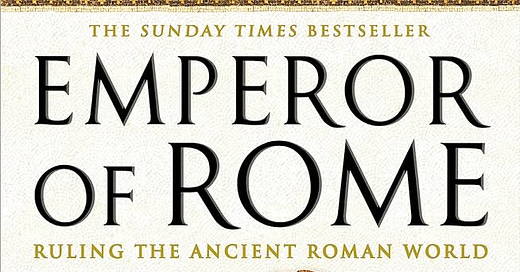Forget the marble statues and cinematic gravitas. Mary Beard’s Emperor of Rome (2023) drags Rome’s rulers down from their pedestals and shows them as they really were—flawed, insecure, and constantly looking over their shoulders.
If you think being an emperor meant unlimited power and divine status, Beard is here to remind you that it mostly meant endless paranoia, backstabbing courtiers, and the constant risk of being stabbed in the bath.
"Nearly everything that we think we know about Roman emperors comes from hostile sources written after their deaths."
Chucking out the standard chronological march from Augustus to Constantine, Beard organises her investigation thematically:
How did one become emperor?
What did the emperor actually do all day?
Where did he live? How did he travel?
What did he eat? How did he host dinners?
Did he have a washroom? What did hygiene mean to him?
Did he actually enjoy being emperor, or was it just a death sentence in slow motion?
The result feels less like a history textbook and more like an anthropological study of a very peculiar profession.
Not a Hall of Fame—Or a Rogues' Gallery
Most books on Rome’s emperors divide them into two camps: the good (say, Augustus or Marcus Aurelius) and the bad (say Nero, Caligula, or Commodus).
Beard refuses to play that game.
She doesn’t focus on individual rulers so much as the role itself—what it meant, how it functioned, and how much of it was just an elaborate performance.
Roman emperors weren’t gods or tyrants in total control. They were figureheads navigating a ruthless system where their survival depended on playing the game just right.
As Beard points out, most emperors didn’t die of old age—either they were assassinated, forced to kill themselves, or met a suspiciously convenient end.
Even the so-called absolute rulers had to keep the Senate, the army, and the people happy, or they wouldn’t last long.
Through careful analysis of administrative documents, Beard reveals how the emperor wasn’t drafting laws—he was answering petitions, settling disputes, and making endless symbolic gestures to keep the illusion of control alive:
"An emperor might command armies, but he spent more time reading and signing documents."
And elsewhere:
"Power was exercised through paperwork, not just the sword."
Beard also reminds you that Rome’s rulers weren’t always sitting in gold-plated halls. They spent an astonishing amount of time on the road, inspecting provinces, meeting generals, and making sure the empire didn’t fall apart.
For every gladiatorial spectacle they hosted, and every increasingly ridiculous statue they commissioned, there were months of mind-numbing official duties.
What Beard gets right
She’s at her best when stripping away the myth-making. Emperors weren’t superheroes or cartoon villains; they were humans navigating a brutally unforgiving system.
Take Caligula, infamous for (supposedly) making his horse a senator. Beard doesn’t dismiss the story outright, but she asks the real question: what did it mean? Was it a joke? A political insult? Propaganda by his enemies? The answer, as with most things in Rome, is complicated.
Her writing is, as always, sharp, witty, and refreshingly skeptical.
She constantly questions how we know what we know, reminding you that most of our sources were written by elite men with political agendas.
She keeps examining the testimony of Roman authors in light of the several extant interpretations we have of limited archaeological evidence.
She’s also great at bringing in the ordinary Romans—the people who had to live under these emperors, celebrate them, fear them, and occasionally riot against them.
Then there are the wives, lovers, family members, household attendants, senators, slaves, and courtiers who made his professional and domestic lives possible.
The book isn’t just about emperors; it’s about the empire as a whole.
What might disappoint you
First, the scope. Beard acknowledges that she had to be selective in her list of emperors. The book spans only the first 15% of the 1500 years for which Roman emperors ruled. It tells you nothing about how the role evolved with time.
Then, there's the structure. Due to the thematic focus, the narrative keeps jumping from one century to another several times within the same chapter.
That’s fantastic if you are already initiated into the history of Rome and just want a fresh perspective.
But it can be excruciating if you are new, and are hoping for a start-to-finish biography of Augustus to Constantine.
She also downplays some of the juicier imperial scandals. This isn’t I, Claudius. You won’t get pages of lurid palace intrigue.
If you came for the drama, you might feel a little shortchanged.
The Verdict: A Reality Check for Rome Lovers
If you want emperors as flawed, fascinating, and all-too-human figures, Emperor of Rome delivers.
It’s less about individual rulers and more about the idea of being emperor—how the job worked, why it was so dangerous, and what it meant for Rome as a whole.
By understanding how Roman emperors actually governed - through paperwork, ritual, and careful image management rather than just brute force - you can gain insights into how autocratic power works in any era.
Read Next:
Try Keith Hopkins's Conquerors and Slaves for a look at Roman social structures.
For a more dramatic take on imperial Rome, Robert Graves’s I, Claudius is still the gold standard of historical fiction. Though, the sequel Claudius the God is closer in tenor to this book.
If you want a deep dive into the Roman Republic’s collapse, Tom Holland’s Rubicon is gripping and cinematic.
And if you want more of Beard’s brilliant but more focused storytelling, SPQR remains essential reading.




